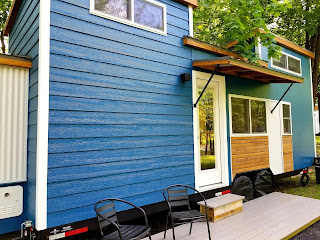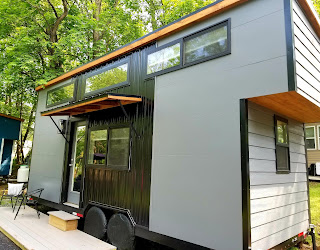Last week we touched based on the importance of having smoke detectors, gas detectors, fire
extinguishers, and considering your means of egress.
Something as simple as unplugging small appliances, heaters, and irons when you are not
using them can save your home from catching on fire. Make sure to keep at least 30” above
your cooktop and the surrounding countertop clear at all times. If you ever accidentally turn your
cooktop on anything that is close by could catch fire very quickly. Never leave your hot
appliances unattended.
If you have electrical cords running constantly, over time they can produce heat so don’t place
them under a rug or between your furniture and the wall.
Know how your propane system works. How to hook it up, replace it and check it regularly.
Install an automatic shut off valve on your propane tank. The shut-off valve will immediately turn
off the propane in the event of a major leak.
Sprinklers in tiny homes are not a common system found in builds. One reason is that a
sprinkler system needs a high water pressure system that is separate from the domestic water
being used for sinks and showering. If you are parking your tiny home in an area where you
Tim Arters, from Greenwood Tiny Homes in Leola, PA tells us that you could install a
freshwater tank underneath the tiny house with a bank of battery backup
to run through a high-pressure pump. The same bank of batteries could also be used
for short term periods of a power outage as well. A sprinkler system would be an efficient
way to put out flames inside your tiny home. However, we mention forest fires, and
that comes with good cause, there have been tiny homes that have been lost in
fires of several origins. There are some structural precautions you can take when building
your home to help make it fire resistant from the exterior also. Steel framing is a
lightweight, non-combustible option for the frame of your tiny home. Steel framing is
also more resistant to water damage, rotting, and warping.
In general, hardwoods are denser than softwoods. These types of wood are slow to burn,
allowing more time to get out of the house. However, hardwoods are more likely to expand and
contract.
All types of wood can be treated with a fire retardant spray. In the event of a fire, if fire retardant
spray has been used, the fire can slow and even stop when it reaches the fire retardant
chemical. You can find fire retardant spray that is nontoxic.
It is easy to forget about safety precautions when designing your tiny home. Taking the time to
think about the precautions that you need to take, can save your life in an emergency. You can
never be too safe especially when it comes to fire prevention.







Comments
Post a Comment